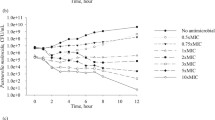Abstract
Traditionally, the in vitro activity of antibacterial agents is characterized by their minimal inhibitory concentrations. However, these endpoints are, by nature, discrete and do not provide information on time-dependent killing of the bacteria during the incubation period. Nevertheless, the pharmacodynamic characteristics of antibacterial agents are almost always defined by correlating a static endpoint describing the antibacterial activity of an agent with the pharmacokinetics, describing the time-dependent fluctuation of drug concentrations. This approach is basically a contradiction in itself. Therefore, it would be more logical to correlate pharmacokinetics to in vitro parameters describing the time- and concentration-dependent antibacterial action of an agent. Thus, experimental methods and mathematical models quantifying the decrease in growth rate of a bacterial population due to the action of an antibacterial agent as a function of time and drug concentration have been applied to quantitate their pharmacodynamics. The effect of nine antibacterial agents representing drug classes of penicillins, cephalosporins, penems, macrolides, and fluoroquinolones were mathematically analyzed by using three different but related models. The kill rate, maximal kill, the 50%-effective concentration (EC50), the Hill coefficient, and concentrations and times needed to obtain a 1,000-fold decrease of the initial number of viable counts were calculated. Both the phenotypic description of the time-kill curves and these five parameters mirror the bacteriostatic or bactericidal activity of all nine agents studied as a function of time and concentration. Therefore, it would be more logical to correlate a parameter quantifying the kinetics of antibacterial in vitro activity with the pharmacokinetics of the drug, thus, replacing static endpoints like minimal inhibitory concentrations.
Similar content being viewed by others
Author information
Authors and Affiliations
Corresponding author
Rights and permissions
About this article
Cite this article
Schaper, KJ., Schubert, S. & Dalhoff, A. Kinetics and Quantification of Antibacterial Effects of Beta-Lactams, Macrolides, and Quinolones against Gram-Positive and Gram-Negative RTI Pathogens. Infection 33 (Suppl 2), 3–14 (2005). https://doi.org/10.1007/s15010-005-8202-2
Issue Date:
DOI: https://doi.org/10.1007/s15010-005-8202-2




